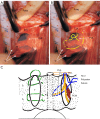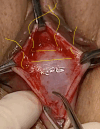Wide-bore polyester sutures may create sufficient collagen for cure of prolapse/incontinence: a work in progress
- PMID: 38721456
- PMCID: PMC11075966
- DOI: 10.21037/atm-23-1774
Wide-bore polyester sutures may create sufficient collagen for cure of prolapse/incontinence: a work in progress
Abstract
The main thrust of the Integral Theory Paradigm (ITP) is that inadequate ligament collagen causes pelvic organ prolapses (POP) and pelvic symptoms, a concept validated by multiple publications which cured POP and bladder/bowel/pain dysfunctions by collagen-creating slings. Sling surgery for surgical cure of these conditions was eliminated in the United States, Europe and other regulatory jurisdictions by banning all mesh products (including tapes) in about 2017. The aim of this work was to inform of the progress of a highly promising alternative method for collage creation for ligament repair: wide-bore polyester sutures accurately applied to weak ligaments. The scientific rationale for the wide-bore polyester plication method was a revisit and analysis of prior Instron testing data from a rejected polyester aortic graft from a doctoral thesis. The analysis indicated that the collagen produced by No. 2 polyester sutures would be sufficient to repair weakened pelvic ligaments. The surgical methodology consisted of application of wide-bore No. 2 or No. 3 polyester sutures to existing vaginal surgical techniques such as cardinal/uterosacral ligament (CL/USL) repair in the Fothergill operation, deep transversus perinei (DTP) ligamentous supports of the perineal body (PB) and uniquely, pubourethral ligament (PUL) repair for stress urinary incontinence (SUI). No vaginal tissue was excised. These operations are now being performed in several centres around the world. Because of this, the results detailed below are indicative only, and necessarily incomplete, as they are only from these units. Twelve month data (n=35) for SUI cure (83%) following PUL repair by the urethral ligament plication (ULP) operation has been submitted for publication; POP quantification (POPQ) points Ba, C, Bp, D were significantly improved at 6 weeks postoperative review following repair of CLs (cystocele) and USLs (uterine/apical prolapse) (n=56): deep transverse perinei ligament repair (descending perineal syndrome "DPS") (n=4) were cured at 6-12 months review. Though numbers are few, in the context of DPS being considered incurable, these numbers are significant. Except for the ULP operation, the techniques for cystocele, uterine prolapse, perineocele were essentially evolved versions of the Fothergill and standard PB repairs without any vaginal or ligament excisions. Though promising, more extensive and longer-term results are clearly required before this wide-bore polyester ligament repair method can become mainstream.
Keywords: Polyester sutures; collagen; descending perineal syndrome (DPS); pelvic organ prolapses (POP); stress urinary incontinence (SUI).
2024 Annals of Translational Medicine. All rights reserved.
Conflict of interest statement
Conflicts of Interest: All authors have completed the ICMJE uniform disclosure form (available at https://atm.amegroups.com/article/view/10.21037/atm-23-1774/coif). The series “Integral Theory Paradigm” was commissioned by the International Society for Pelviperineology without any funding or sponsorship. The authors have no other conflicts of interest to declare.
Figures


















References
Publication types
LinkOut - more resources
Full Text Sources
